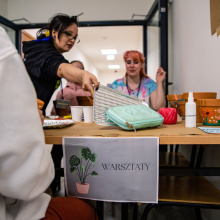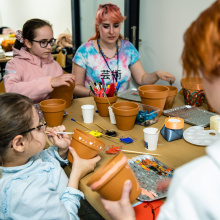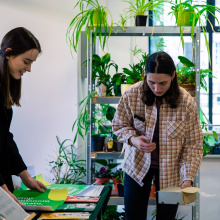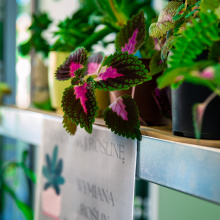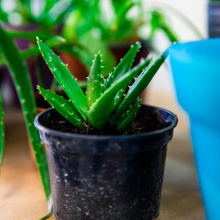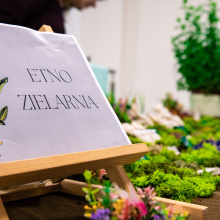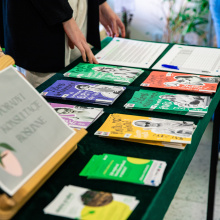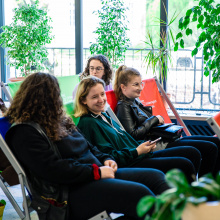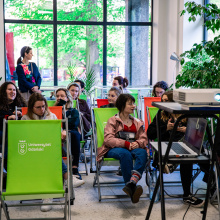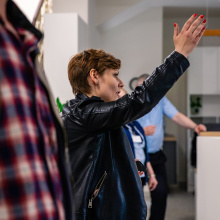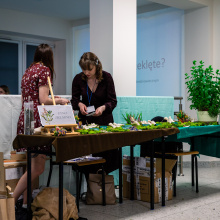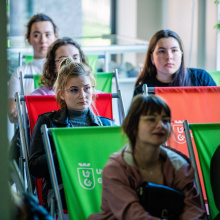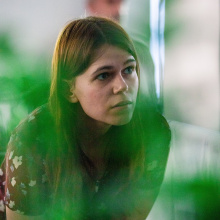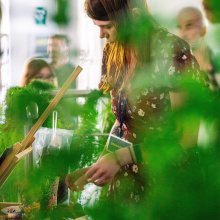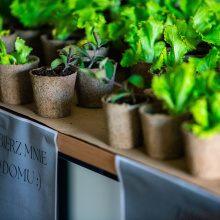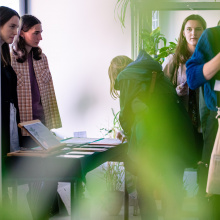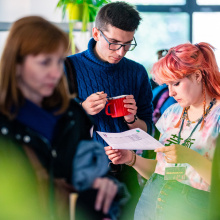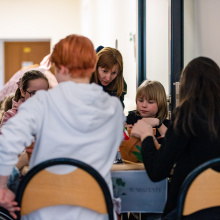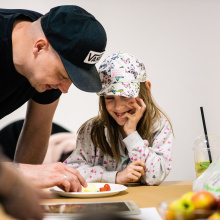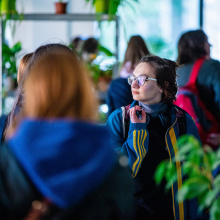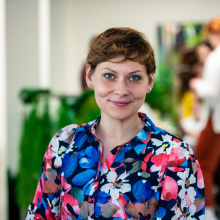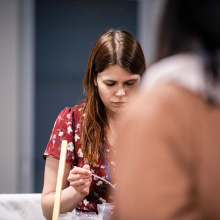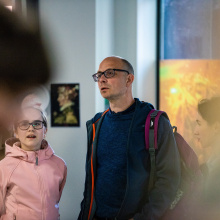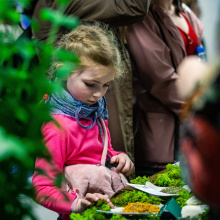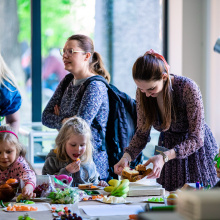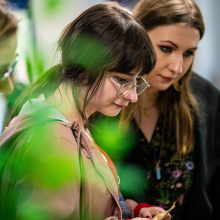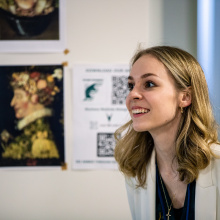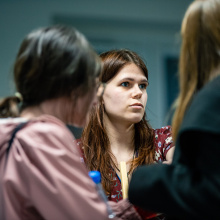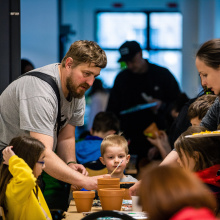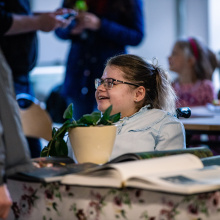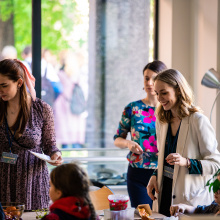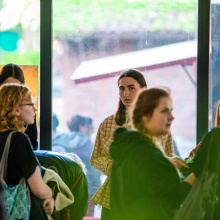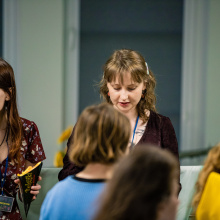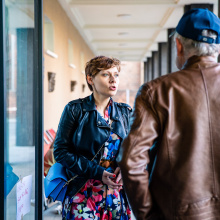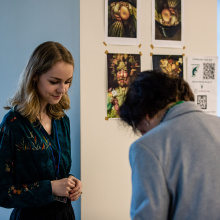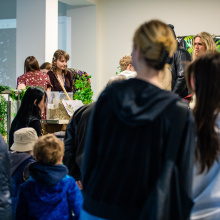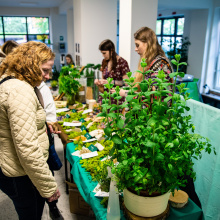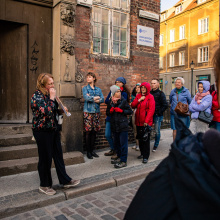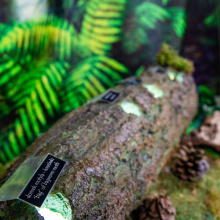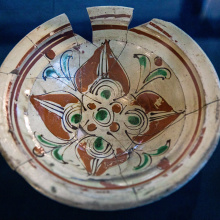For the first time, the University of Gdańsk Museum took part in the European Night of Museums. This year, the main theme of the event was plants. Participants could create a painting out of fruit, paint a pot to resemble old pottery and learn about the medicinal use of herbs.
The event started with a lecture by Wiktoria Barzowska from the Art Historians Club at the University of Gdańsk entitled 'Sacred or cursed? Or the symbolism of plants in medieval painting'. The second-year History of Art student talked about religious representations of flora and raised issues related to the colour of priests' pulpits and the meaning of lilies.
Comparison - baskets of fruit found on pottery and their likely inspiration.
The first presentation was a good introduction to the next lecture, entitled 'Garden interiors of Gdańsk houses. Flowers and other plants on ceramic wares in the 17th century', led by dr Joanna Dąbal and mgr Karolina Szczepanowska from the Institute of Archaeology UG. The researchers talked about secular representations of plants on ceramics and looked for the potters' inspirations. They also focused on single species of flowers and their images. - 'Tulips appeared in Europe in 1559 and the late 16th century in the Netherlands. Thanks to the developed trade conducted by the Dutch, as early as in the same century we could see images of this flower on ceramics in Gdańsk,' - said dr Joanna Dąbal.
In addition to lectures, the event also featured many workshops. The PLONY Foundation offered free plant advice and consultations. - 'People are interested in the plant exchange stand. They don't know what species it is, so they ask us. Others are concerned that their plants are sprouting flowers, as this is a rare sight,' - said Agata Biernacik of the Plony Foundation, who co-managed the stand.
'Eat Your Painting' Workshop
Giuseppe Arcimboldo enthusiasts could create a work in the style of the master at the 'Eat Your Painting' stand. Participants could also develop their painting enthusiasm at a family workshop on pot decoration. With the theoretical background provided by the lectures, some participants reproduced images of flowers on their pots. - 'Although floral designs predominated, we allowed our participants to let their imaginations run free. Some works entered surrealism and even cubism. Geometric motifs and overlapping waves in different colours were repeated,' - said Stella Mańska, an Ethnology student who led the workshop.
There was also education on various herbs and plants. Dr hab. Anna Kwaśniewska, prof. UG talked about different uses of wild flora. A researcher from the Department of Ethnology and Cultural Anthropology presented the health values of lime, mint, elderberry and birch. Attendees could obtain some of these herbs at the Ethno-Greenhouse stand, where a group of students had prepared an exhibition of herbs fit for drinking. Prof. Anna Kwaśniewska also spoke about the use of plants in cooking. - 'Borscht was used to make a sour soup. This is probably why the name "borscht" also applied to other sour-tasting soups that were not made from this plant,' - the researcher said.
Nastasya Fiodorowna and Agata Biernacik, the founders of the Plony Social Initiative who run a community garden in the Gdańsk Shipyard, talked about how to grow your own plants. The speakers talked about the four necessary elements in organising such a project - space, resources, people and a dream - and encouraged the participants to start their own gardens.
dr Kacper Świerk
The participants were introduced to the world of South American flora and fauna by the speaker in the last lecture - dr Kacper Świerk from the Department of Ethnology and Cultural Anthropology. The researcher talked, among other things, about the mythology of one of the Amazon tribes, according to which animals perceive themselves as humans and others as animals. - 'For example, a jaguar sees humans and other game animals as pigs, and pigs see humans as jaguars,' - explained dr Kacper Świerk.
The whole event was organised by the University of Gdańsk Museum. - 'It all started when the Baltic Sea Cultural Centre asked us to open our historic hallway with plant ornaments. I thought it would be possible to develop this event and present the theme of plants in a different way,' - says the Director of the University of Gdańsk Museum, mgr Marta Szaszkiewicz. - 'Already in the middle of the evening, we ran out of pots to paint from the children's workshop, and the lecture rooms were not able to accommodate all the participants. Our pots from the "Adopt a Plant" stand also quickly disappeared.' - This is the first Night of the Museums that the University of Gdańsk Museum has been involved in, but as the organisers suggest it certainly won't be the last.

